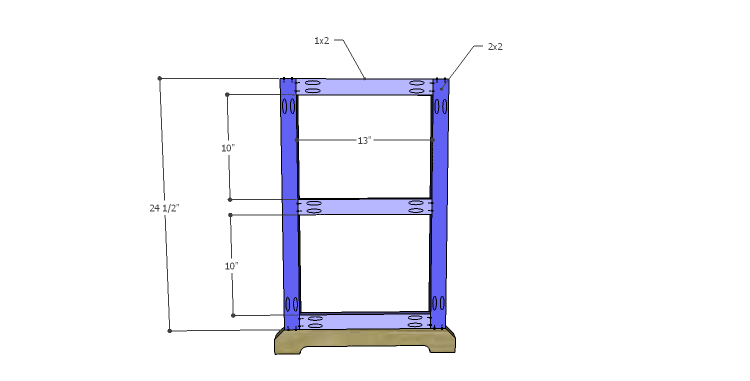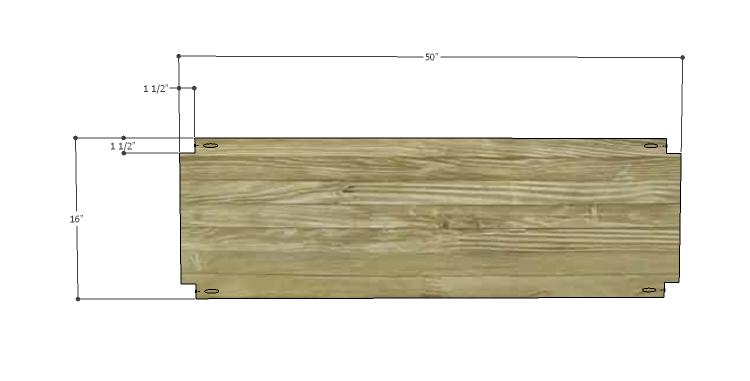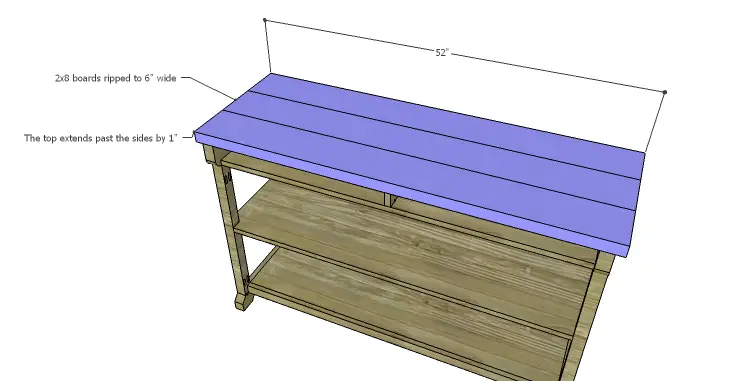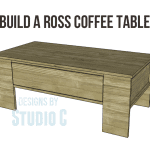A Fabulous Console Table You Can Easily Build…
This is a console table with a rustic, country look. I think it would be beautiful in a chippy, distressed finish! The DIY plans to build a Sweeten Console Table feature a planked top, curved sides as well as curved drawer fronts (the bottom edge), and two shelves. This is a relatively easy build and should be fairly inexpensive!

Materials:
- 1-1/4″ pocket hole screws (<– affiliate link!)
- 2-1/2″ pocket hole screws (<– affiliate link!)
- 2-1/2″ screws
- Edge banding, optional (<– affiliate link!)
- 2 sets of 16″ drawer slides (<– affiliate link!)
- Wood glue
- Sandpaper (100, 150, 220 grits)
- Finishing supplies (primer & paint, or stain, sealer)
Lumber:
- 2 – 1×2 at 8′
- 2 – 1×3 at 8′
- 1 – 1×4 at 6′
- 1 – 1×6 at 4′
- 2 – 2×2 at 6′
- 1 – 2×3 at 4′
- 1 – 2×4 at 4′
- 3 – 2×8 at 6′
- 1 – sheet of 3/4″ plywood
Cut List:
- 2 – 2×3 at 18″ – Feet
- 4 – 2×2 at 24-1/2″ – Legs
- 6 – 1×2 at 13″ – Side Stretchers
- 2 – 2×4 at 18″ – Upper Side
- 2 – 1×2 at 47″ – Lower Stretchers
- 1 – 1×4 at 47″ – Upper Back
- 1 – 3/4″ plywood at 13″ x 47″ – Lower Shelf
- 1 – 3/4″ plywood at 16″ x 50″ – Middle Shelf
- 1 – 3/4″ plywood at 16-1/4″ x 47″ – Drawer Shelf
- 1 – 1×4 (ripped to 2-3/4″ wide) at 16-1/4″ – Drawer Divider
- 3 – 2×8 (ripped to 6″ wide) at 52″ – Top
- 2 – 3/4″ plywood at 14-1/2″ x 20-5/8″ – Drawer Box Bottom
- 4 – 1×3 at 14-1/2″ – Drawer Box Sides
- 4 – 1×3 at 22-1/8″ – Drawer Box Front & Back
- 2 – 1×6 (ripped to 3-3/8″ wide) at 23-5/16″ – Drawer Fronts

Click on the drawings for a larger view!
Step One
Cut the pieces for the feet. Mark the position for the bevel on the top of each foot as shown in the drawing. Cut the bevel using a miter saw or a jigsaw. Draw the curve on the lower edge of the leg. The radius is 3/4″. Cut the curves using a bandsaw or a jigsaw. Clamp the pieces together and thoroughly sand.
Cut the pieces for the legs and the side stretchers. With the pocket hole jig set for 1-1/2″ material, drill pocket holes in each end of the legs. Secure the legs to the feet as shown using glue and 2-1/2″ pocket hole screws.
Set the pocket hole jig for 3/4″ material, and drill pocket holes in each end of the stretcher pieces. Secure the stretchers to the legs as shown using glue and 1-1/4″ pocket hole screws. The back face of the stretchers will be flush with the inside faces of the legs.
Cut the 2×4 piece for the upper sides. Cut the curve in the lower edge of the front of the piece (a 1″ radius) using a bandsaw or a jigsaw. The piece will extend past the legs by 1″. Secure to the legs using glue and 2-1/2″ pocket hole screws.



Step Two
Cut the pieces for the back and the lower stretchers. Drill pocket holes in each end of each piece. Secure the lower stretchers to the legs as shown using glue and 1-1/4″ pocket hole screws. Position the stretchers so they are located 3/4″ back from the outside faces of the legs.
Secure the back to the back edge of the upper sides using glue and 1-1/4″ pocket hole screws. The outside face of the back will be flush with the outside edge of the upper sides.

Step Three
Cut the piece for the lower shelf and drill pocket holes in all four edges. Secure the shelf inside the lower 1×2 stretchers using glue and 1-1/4″ pocket hole screws. The top face of the shelf will be flush with the top edge of the lower stretchers.

Step Four
Cut the piece for the middle shelf. Apply edge banding to all four edges, if desired. Cut the notches using a jigsaw, and use a portable pocket hole jig (set for 3/4″ material) to drill pocket holes in the notches as shown. Secure the shelf to the legs as shown using glue and 1-1/4″ pocket hole screws.


Step Five
Cut the piece for the drawer shelf and apply edge banding to one long edge, if desired. Drill pocket holes in the opposite long edge as well as each side edge. The shelf will be butted up against the back which in turn makes it located 1″ back from the front edge of the upper sides (lined up with the outside face of the legs). Secure the shelf to the upper sides and back using glue and 1-1/4″ pocket hole screws.
Cut the piece for the drawer divider. Drill pocket holes in one long edge and one short edge as shown. Secure to the drawer shelf and the back, as shown, using glue and 1-1/4″ pocket hole screws.


Step Six
Cut the pieces for the top. The side edges of the top will extend 1″ past the sides. Spread glue on the top edge of the upper sides and back, and position the top boards. Drill countersunk holes through the top boards into the upper sides and secure the top using 2-1/2″ screws.

Step Seven
Cut the pieces for the drawer boxes. Drill pocket holes in all four edges of the bottom as well as each end of the sides. Assemble the drawer boxes as shown using glue and 1-1/4” pocket hole screws. Install the drawer slides according to the manufacturer’s installation instructions, locating them 1” back from the front edge of the upper sides. Check out this easy tutorial on installing drawer slides. Make any necessary adjustments.


Step Eight
Cut the pieces for the drawer fronts. Use a router and a 3/4″ roundover bit to round one long edge of each piece. There will be a 1/8″ gap at the sides and top of the drawer fronts in the openings, as well as in between the two. Spread glue on the drawer box front and position the drawer front. Drive a few 1-1/4″ brad nails through the drawer front into the drawer box. Add drawer pulls, if desired.


Fill all holes and finish as desired!
The Sweeten Console Table would be a great addition to any room – the dining room, the entryway, or even a bedroom! Have any questions about the DIY Plans to Build a Sweeten Console Table? Leave a comment below or contact me at cher {at} designsbystudioc {dot} com!
Originally posted 2014-09-29 08:00:48.






Comments are closed.